Chile Travel Information
We listed all important information for your trip to Chile to help you with your travel preparations. You can not only find information about the best time to travel but also important adresses and telephone numbers. Experience the dryest desert on earth, volcanos, geysirs, beaches and the enchanting Patagonia. Travel to Chile with SC Travel Adventures.
Entry & Exit
For stays up to 90 days you do not need a visa. At arrival you receive a tourist card (Tarjeta de Turismo), which you need to turn back at your departure. If you are planning to stay longer than 90 days in Chile, you can extend your stay for another 90 days at the Chilean immigration office in Santiago. The application is due at least on month before expiration date of your current tourist card.
There are strict regulations for the entry of children. Please contact the nearest Chilean embassy or consulate before your tour to make sure you are up to date with the latest requirements.
The import of agriculture products is strictly limited. Make sure to declare all products arriving to Chile. This also applies to packaged items.
For the custom regulations at your reentry to Canada/UK please see special regulations at Global Affairs Canada or the Foreign and Commonwealth Office.
For the Easter Island you need to have a valid vaccination agains Yellow Fever (for all persons above the age of one year), if you are arriving from a Yellow Fever area.
You should check your common vaccination.Zika virus
On the mainland there only cases of introduced infections of the virus. On the Easter Island there are mosquitos, which are transmitting the virus. Pregnant women are disadvised to travel to the Easter Island.
There are no known cases of Malaria in Chile
Dengue Fever
The sickness is only common on the Easter Island. If you are infected, symptoms are similar to the flu (fever, growing pains). Usually you also get rashes. Due to no available vaccination or other protection, it's recommended to wear long sleeve clothing, use insect repellants and sleep under a mosquito net.
Leishmaniasis
Leishmaniasis is a very rare sickness in Central and North Chile and is transmitted by sandflies. It's recommended to protect youself from mosquitos.
General tips: Before travelling you should contract a foreing travel insurance. This insurance should always include a transport back to your home country in case of emergency.
In bigger cities the medical standards are similar to the western standard. In rural areas you should be prepared to lower standards (hygiene etc.)
Travel Facts for Chile
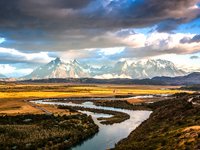
Chile is located in the Southern hemisphere, which means the seasons are inverted. Due to the enormous length of the country you can find very different climates. The rainy season in Chile is from May to October.
In the north of the country you can find moderate temperatures all year. In the coastal areas the temperatures range between 15 and 30°C and it's mostly sunny. Santago and Central Chile have the best weather from September to April. The best time to travel Southern Chile is in the months from October to April.
Chile is falling into UTC -4 time zone and makes use of daylight saving time. During summer time Chile uses the UTC - 3 time zone. The Easter Island is falling into UTC -6 or UTC -5 (Summer time) time zone.
The Chilean currency is the Peso. Until 1976 1 Peso could be devided into 100 Centavos. The devision is not used anymore. The following bank notes are available: 500, 1.000, 2.000, 5.000, 10.000 and 20.000 Pesos. Coins are availabe for 1, 5, 10, 100 and 500 Pesos.
Exchange rate:1 CAD = 541,31 Pesos (last updated 06.09.2019)
1 £ = 878,97 Pesos (last updated 06.09.2019)
In all bigger cities you can pay with credit cards, in rural areas problems might occur. Withdrawing money is possible at almost all ATM's. Please keep in mind, not to have a lot of cash with you.
Electricity
The line voltage in Chile is 220 V / 50 Hz. Plug and power sockets are of Type C or L.
Telephone
International Dialing Code: +56
In bigger cities in Chile you can use public telephone cabins. You can also buy prepaid cards for your cell phone. In Torres del Paine and other isolated areas of the Panamericana the mobile network is not or only partly ensured.
Internet
In most regions you can find fast internet and Wifi. In bigger cities there are also a lot of Internet cafés, where you can use the internet for a low price.
Nueva Tajamar 481, Torre Norte, 12th Floor, Las Condes, Santiago de Chile
Tel.: +56 2 2652 3800
Internet: www.chile.gc.ca Consulate of Canada (Antofagasta)
Tel.: +56 9 4714 8126
In-Person service is available in Antofagasta by appointment only. British Embassy (Santiago)
Avda. El Bosque Norte 0125, Las Condes, Santiago de Chile
Tel.: +56 2 2370 4100
Internet: www.gov.uk/contact-consulate-santiago Important telephone numbers:
Ambulance: 131
Fire Fighters: 132
Police: 133
People & Landscape
There are 18 million people living in Chile, 75% of them are offsprings of European immigrants and only 10% are indigenous. The capital is the metropolis Santiago de Chile.
The official language of the country is Spanish. Nevertheless the Chileans are hard to understand due to there strong dialect. There are also words, that are only used in Chile.
About 70% of the population is part of the Catholic community. The influence of the church on the daily life is quite big, for example on the law and culture. Religious minorities are mostly Protestants, natural religions, mormons and jews.
The culture is influenced by the folclore and traditionals dances - like the national dance Cueca. Also the public singers with there songs from love dreams are very popular.
The indigenous influnces are notable in the art - for example in weaving and pottery. In rural areas around the capital you can find the Huasos (Cowboys), that are taking an integral part in the culture.
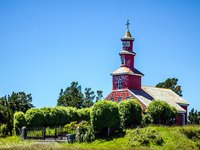
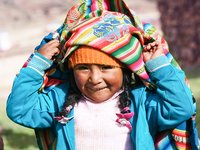
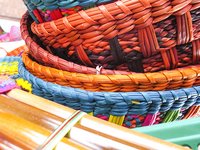
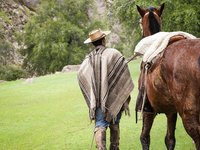
Chile has much to offer: In the north you can find the Atacama destert, the dryest desert in the world, where you can get enchanted by the gorgeous sky full of stars. The flora is consisting of different types of catuses, succulents and dwarf-shrubs. On the coasts you can find humboldt-penguins, pelicans and seals.
Central Chile is the most populated region of the country, which is due to the location of Santiago de Chile and Valparaíso in this regions. In the fertile valley between the coast and the highlands, wine and fruits are cultivated.
If you are travelling further to the south you will encounter the "little south" first, a region full of lakes, rifers and snow-covered volcanos. The most southern part of the country is called "big south" and builds the western Patagonia. Glaciars, lakes, fjords and many small islands are creating a unique landscape. Close to the mainland, you can find the island Tierra del Fuego, which Chile is sharing with Argentina. Here you can find Magellan-Foxes, Darwin-Rheas and Magellan-Penguins. You can also visit Cape Hoorn, the most southern point of South America. One of the highlights in Patagonia is a hike in the nationalpark Torres del Paine, where you can experience breathtaking nature.
In almost all regions of Chile you can encounter one of the biggest birds in the world - the Andean condor.
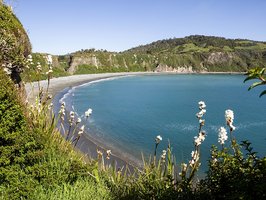
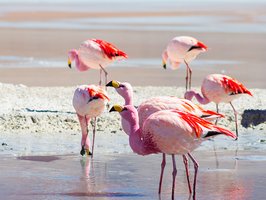
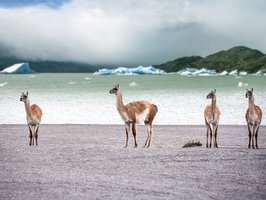
The Chilean cuisine is influenced by the Europeans and indigenous. The national dishes are Empanadas - pastry filled with beef, chicken, seafood or cheese. A typical snack is the completo - a hotdog with mayonaise, avocado, tomato and ketchup - or the Humita (made from corn). Another typical dish is the Spaipilla: a fried bread with sweet (chancaca) or spicy (pepre) sauce.
Due to the location on the ocean, the country has a lot of seafood to offer. They are either made in the pan (frito) or at the grill (a la plancha).
The Pisco Sour is part of the Chilean and Peruan culture - the popular aperitif is made from the grape liqour Pisco from Northern Chile and lime juice and sugar. You should also try the great Chilean wines. The most popular red wines are Cabernet, Sauvignon and Merlot. Great white wines are Chardonnay and Sauvignon Blanc.
If you are well informed about Chile now, have a look at our Trips to Chile or contact our team.
Current Situation
Please keep in mind, that the security situation at place can change at any time. Therefore we recommend to have a look at the current safety information at Global Affairs Canada or Foreign and Commonwealth Office.
Exclusion of Liability
Those who choose to travel do so entirely at their own risk. SC Travel Adventures endeavours to inform tourists of the risks involved with travelling but cannot be held liable for any events which occur outside of their direct control. Tourists are advised to avoid areas considered unsafe, remain vigilant and cautious at all times throughout their stay, and heed the advice of local authorities.
